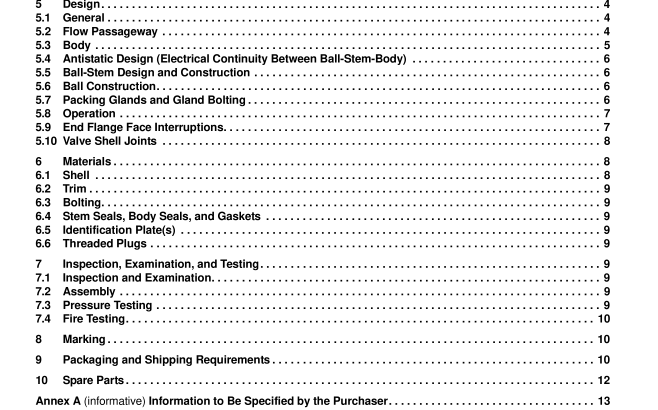API St 608:2012 pdf free download.Metal Ball Valves—Flanged, Threaded, and Welding Ends
5.3.9 Upstream sealing, trunnion-mounted ball valves shall have a test port into the body cavity between seats to allow seat testing as specified in API 598. This test port shall have taper pipe threads in accordance with ASME B.1.20.1 and shall be fitted with a solid test plug conforming to ASME B16.11 . Additional tapped openings are permitted only when specified in the purchase order and shall have taper pipe threads in accordance with ASME B.1.20.1 .
5.3.10 If drain, bypass, or other types of auxiliary connections are specified in the purchase order, they shall comply with the requirements of ASME B16.34.
5.3.11 When specified in the purchase order, body cavity overpressure shall be in accordance with ASME B16.34.
5.4 Antistatic Design (Electrical Continuity Between Ball-Stem-Body) Valves shall incorporate an antistatic feature that insures electrical continuity between the stem and body of valves ≤ DN 50 ( ≤ NPS 2) and between the ball, stem, and body of valves > DN 50 (> NPS 2).
The antistatic feature shall have electrical continuity across the discharge path with a resistance not exceeding 1 0 ohms from a power source not exceeding 12 VDC when type tested on a new, dry, as-built valve after open-close position cycling of the valve at least five times.
5.5 Ball-Stem Design and Construction
5.5.1 The valve shall be designed to ensure that if a failure occurs at the stem-to-ball connection or of the stem itself within the pressure boundary, no portion of the stem is ejected by internal pressure.
5.5.2 The torsional strength of both the stem-to-ball connection and the portion of the stem within the pressure boundary (below top of packing) shall exceed the torsional strength of the stem portion above the pressure boundary (above the top of the packing) by at least 1 0 % at the maximum valve rated temperature. 5.5.3 The stem and the ball-to-stem connection shall be designed such that no permanent deformation occurs and no failure of any part occurs when a force applied to the lever or gear operator handwheel produces a torque equal to the greater of:
— 20 N-m (1 5 ft-lb) or — twice the manufacturer’s maximum published torque. The manufacturer’s maximum published torque shall be based upon clean, dry air service at the maximum differential pressure rating of the valve.
5.6 Ball Construction Ball shall have a cylindrical bore and shall be of solid one-piece construction. Other constructions such as “hollow”- type, cored cavity, or sealed cavity may be furnished only if agreed to by the purchaser.
5.7 Packing Glands and Gland Bolting
5.7.1 Adjustable packing glands shall be accessible for resealing stem packing without the disassembly of valve parts or operator parts.
5.7.2 Packing glands that are threaded into bodies or covers or onto stems shall not be used for valve sizes greater than DN 80 (NPS 3) unless otherwise specified by purchaser. (See Figure B.1 and Figure B.2 for parts identification.)
5.7.3 Vertically split glands shall not be used.
5.7.4 When used, gland bolts shall pass through holes in the packing gland. The use of open slots is not permitted on any portion of the packing gland.
5.7.5 Packing gland bolts shall be designed so that the bolt stress shall not exceed 1 / 3 of the ultimate tensile strength of the bolting material when compressing packing material to a compressive stress of 38 MPa (5500 PSI) at 38 °C (100 °F).
5.8 Operation
5.8.1 Unless otherwise specified on the purchase order, manually operated valves shall be equipped with lever-type handles.
5.8.2 Gear operators shall be fitted with handwheels and shall be sized to comply with the requirements of 5.8.3.
5.8.3 Unless otherwise specified by the purchaser, the length of the lever handle or the gear ratio, efficiency, and handwheel diameter of gear operators shall be designed so that the required input force to fully open and close the valve shall not exceed 360 N (80 lb) when operating the valve at the manufacturer’s maximum published torque as described in 5.5.3.API St 608 pdf download.API St 608:2012 pdf free download
